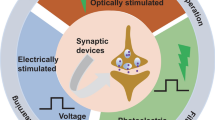Abstract
The results of a previous theoretical study of a class of systems are applied for the design of neural nets which try to simulate biological behavior.
Besides the models for single aperiodic and periodic neurons, a “neural oscillator” is developed which consists of two cross-excited neurons. Its response is similar to the firing pattern of certain biological neural oscillators, like the flying system of the locust. Also, by proper change of its parameters, it can be made highly irregular, providing a deterministic model for the spontaneous neural activity.
Similar content being viewed by others
Literature
Bertaux, D. 1963.Mathematical Model of a Synapse. M.S. Research Project (Plan II), Dept. Electr. Engr., University of California, Berkeley; Sept.
Crane, H. D. 1962. “Neuristor—A Novel Device and System Concept.”IRE Proc.,50, No. 10, 2048–2060.
Fetz, E. E. and G. L. Gerstein. 1963. “An RC Model for Spontaneous Activity of Single Neurons.”MIT Quarterly Report of the Res. Lab. of Electronics,71, 249–256.
Gardner, M. F. and J. L. Barnes. 1942.Transients in Linear Systems. New York: J. Wiley.
Gerstein, G. L. and B. Mandelbrot. 1964. “Random Walk Models for the Spike Activity of a Single Neuron.”Biophysical Journal,4, No. 1, pt. 1, 41–68.
Harmon, L. D. 1961. “Studies with Artificial Neurons, I: Properties and Functions of an Artificial Neuron.”Kybernetik,1, No. 3, 89–101.
— 1962. “Neural Analogs.”Proc. of the Spring Joint Computer Conference, San Francisco,21, 153–158.
Hiltz, F. F. 1963. “Artificial Neuron.”Kybernetik,1, No. 6, 231–236.
Jury, E. I. and T. Pavlidis. 1963. “A. Literature Survey of Biocontrol Systems.”IEEE Trans. on Automatic Control,8, No. 3, 210–217.
Kalman, R. E. 1956. “Nonlinear Aspects of Sampled-Data Control Systems.”Proc. of the Symposium on Nonlinear Circuit Analysis, Brooklyn Pol. Inst., 273–313.
Landahl, H. D. 1961. “A Note on Mathematical Models for the Interaction of Neural Elements.”Bull. Math. Biophysics,23, 91–97.
Lewis, E. R. 1963. “An Electronic Analog of the Neuron Based on the Dynamics of Potassium and Sodium Ion Fluxes.”Semi-Annual Report No. 6, The Lab. for Automata Research, General Precision, Inc., 57–109, Jan.
Li, C. C. 1961.Integral Pulse Frequency Modulated Control Systems. Ph.D. Dissertation, Northwestern University.
Nelson, P. P. 1962. “Un Modele du neurone.”Bull. Math. Biophysics,24, 159–181.
Ormsby, J. F. A. 1962.On the Generation of Markov Chains. Electr. Res. Lab. Report No. 60-480, University of California, Berkeley.
Pavlidis, T. 1963.Neural Pulse Frequency Modulation Control Systems. Int. Tech. Memo, M-15, Electronics Research Lab., University of California, Berkeley.
— 1964.Analysis and Synthesis of Pulse Frequency Modulation Feedback Systems. Ph.D. Dissertation, Dept. of Electrical Engineering, University of California, Berkeley. Also available as an Electronics Research Laboratory Report No. 64-13, March 10, 1964.
Pavlidis, T. and E. I. Jury. 1965.Analysis of a New Class of Pulse-Frequency Modulated Feedback Systems. IEEE Transactions on Automatic Control.
Rashevsky, N. 1960.Mathematical Biophysics, 3rd Edition, Vol. 1, and 2. New York: Dover Publications, Inc.
Ruch, T. C. and J. F. Fulton. 1960.Medical Physiology and Biophysics. Philadelphia: W. B. Saunders.
Wilson, D. M. 1961. “The Central Nervous Control of Flight in a Locust.”Jour. Exper. Biology,38, 888–908.
Wilson, D. M. and T. Weis-Fogh. 1962. “Patterned Activity of Coordinated Motor Units, Studied in Flying Locusts.”Jour. Exper. Physiology,39, 643–667.
Wilson, D. M. and E. Gettrup. 1963. “A Stretch Reflex Controlling Wingbeat Frequency in Grasshoppers.”Jour. Exper. Physiology,40, 171–185.
Zadeh, L. A. and C. A. Desoer. 1963.Linear System Theory—The State Space Approach. New York: McGraw-Hill.
Author information
Authors and Affiliations
Rights and permissions
About this article
Cite this article
Pavlidis, T. A new model for simple neural nets and its application in the design of a neural oscillator. Bulletin of Mathematical Biophysics 27, 215 (1965). https://doi.org/10.1007/BF02498776
Received:
DOI: https://doi.org/10.1007/BF02498776




